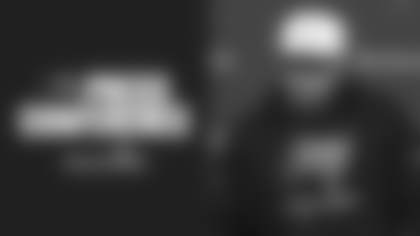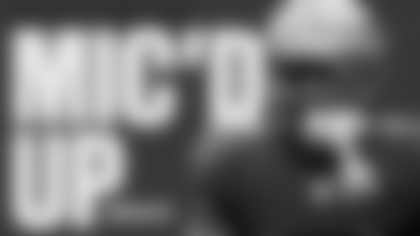The most critical player in regards to the 2012 NFL free agency class of offensive lineman is probably Drew Brees.
Brees isn't even big by quarterback standards, so the New Orleans Saints record-breaking passer isn't going to be converting to O-Line any time soon. But the decisions he and the Saints make over the next fortnight may determine whether the biggest offensive line prize in free agency – potentially the most coveted player at any position – hits the open market.
With the start of free agency less than two weeks away, and the deadline for applying franchise tags looming even closer, the Saints are poised to make major news one way or another. Both Brees and Pro Bowl guard Carl Nicks are scheduled to become unrestricted free agents on March 13 (as are receivers Marques Colston and Robert Meachem, but Brees and Nicks seem like jobs 1a and 1b for the Saints) and it's obvious the team wants both of them back. The question is, will the Saints be forced to use their franchise tag on Brees, making it possible for Nicks to hit the market? Or will a new Brees contract come in time for the franchise tag to go to Nicks instead? Or do the Saints have some other plan for their two superstars altogether?
In this regard, the offensive line position is much like defensive line when it comes to this year's potential free agency class, in that there is one obvious standout in the group who may or may not actually make it to the open market. There are several other attractive options for O-Line shoppers this spring, as we'll discuss below, but Nicks would immediately make that group much stronger.
It's not all about Nicks, of course. The offensive line is comprised of five different positions, or at least three if one considers the left and right sides interchangeable at guard and tackle, and this free agency class will match up players and needs differently for different teams. The Tampa Bay Buccaneers, for example, would seem less likely to go after tackles after re-signing both Donald Penn and Jeremy Trueblood over the last two years.
In addition, a more normal offseason schedule in 2012, after last year's months of inactivity due to the labor impasse, will affect some teams approach to the offensive line in free agency. This year, as in most years, free agency begins well before the draft, and teams looking for help up front will have to weigh their options between the two. The 2012 class of draft prospects is considered somewhat deep along the line, with not only a handful of likely first-round tackles but even two or three interior linemen who could go in the opening frame, which is a bit more unusual.
Offensive line is also a position group at which few teams are ever truly set across the board, the Saints of recent vintage being one of the exceptions. With five positions to keep filled with the best available talent, and the depth behind it very difficult to maintain and build, most teams would happily address that position in free agency or the draft if the opportunity arose. This year, the Buccaneers have announced their intentions to make greater use of the free agent market, and even though the team's offensive line was one of its most consistent positions in 2011, one can't rule it out as a target for Tampa Bay.
The 2012 free agency period begins at 4:00 p.m. ET on Tuesday, March 13. Buccaneer decision-makers obviously do not plan on sharing their free agency strategies beforehand, but we can still survey the landscape, in regards to both team needs and the possible pool of free agents, before the opening bell. This is the sixth in a series of position-by-position primers prior to the start of free agency on Buccaneers.com. Once again, we will be discussing five categories of information in each article:
- How might the Buccaneers' own list of pending free agents affect the position?
- What level of talent will potentially be available at that position on the open market?
- How effectively could a need at that position be addressed in the early rounds of the draft instead?
- What is the Buccaneers history in free agency at that position?
- How did that position perform for the Buccaneers in 2011?
We looked at the defensive line in our last primer and now assess the men in the other side of the trenches. Previous entries have looked at safeties, wide receivers, linebackers and tight ends. Coming up next: cornerback. As always, player evaluations and other points of conjecture are not meant to reflect the opinion of the Buccaneers' coaches or player personnel staff.
**
Positional Free Agency Primer: Defensive Line
- Tampa Bay's own pending free agents
The Buccaneers have a bit of a mixed bag when it comes to their own pending free agents along the offensive line. There are three players on the list – one starter, two reserves; two unrestricted free agents and one restricted; one previous draftee, two undrafted free agents.
The priority for the Buccaneers in that group is pretty clearly fifth-year guard Jeremy Zuttah, and there have been reports that the two sides are talking about a deal prior to the start of free agency. A third-round pick in 2008 out of Rutgers – coincidentally and perhaps significantly the former home of new Tampa Bay Head Coach Greg Schiano – Zuttah started 14 games at left guard last year and is considered an ascending player.
The Buccaneers drafted Zuttah with an eye towards his impressive versatility – he played virtually every spot on the line during his time at Rutgers – and that has indeed become one of his more valuable assets. Zuttah has made starts at all three interior line positions during his NFL career and is even considered an emergency option at tackle. That kind of multi-positional ability is helpful to teams trying to get down to the 46-man active player limit on game day, but Zuttah is likely to find a more permanent spot if he re-signs with the team.
Tackle James Lee is also due to become an unrestricted free agent. Lee performed well during the second half of the 2010 season at right tackle after injuries slowed Trueblood, but he saw very little playing time in 2011 as Trueblood reclaimed his spot. The Bucs other reserve tackle from 2011, Demar Dotson, is in line to become a restricted free agent, which means the team could, for all practical purposes, lock him up with the right tender offer. Dotson is a bit of a wild card; a basketball player at Southern Miss, he played only a little college football, and that was on the defensive line. A combination of size and quick feet makes for an intriguing O-Line project, but Dotson has seen very little actual regular-season playing time on offense.
Again, Zuttah is the clear priority for the Buccaneers among their own free agent linemen, with the eventual decisions on Lee and Dotson hinging on how satisfied the team is with its offensive line depth.
- The potential free agent market
Nicks joined his teammate Jahri Evans as the NFC's starting guards in the Pro Bowl this season (Tampa Bay's own Davin Joseph filled out that group in Hawaii) and many consider him the best at his position in all of football right now. Nicks and Evans were, in fact, chosen as the two Associated Press All-Pro first team guards in 2011. It could complicate matters, beyond the already significant complication of Brees' free agency, that Evans received a large contract from the Saints just a year ago. At 6-5 and 345 pounds, Nicks is huge and powerful but he has also excelled in pass-blocking, as has the New Orleans line as a whole in front of Brees.
Baltimore's Ben Grubbs is in a position somewhat similar to that of Nicks, in that his team has another very high-priority free agent to attend to. That would be the man Grubbs blocks for, standout running back Ray Rice. The Ravens would seem to be motivated to keep Grubbs, a first-round pick in 2007, as he has been one of the best players on a very good offensive front. Again, that's a situation similar to Nicks', and it means Grubbs could become option number one for guard-seekers if Nicks is locked up by the Saints.
San Diego's Jared Gaither is an interesting name on the possible free agency list. He signed a one-year deal with the Kansas City Chiefs as an unrestricted free agent last after missing most of his final season in Baltimore with a back injury. Gaither didn't play much, and was hit with a very costly penalty in a loss to Pittsburgh when he did get in, but it was still something of a surprise when the Chiefs waived him. He was claimed by the Chargers and went on to start five games, drawing very good reviews for his play. Teams considering Gaither have a lot of conflicting information to weigh, but he might be the most promising tackle option on the market.
Buffalo's Demetrius Bell doesn't necessarily have a lot of league-wide name recognition, but he was playing well for the Bills during the first half of 2011 before suffering a season-ending injury. Whether coincidence or not, the Bills' season took a turn for the worse when he was out.
Interestingly, the market for centers might be quite strong, as Green Bay's Scott Wells, Houston's Chris Myers and San Diego's Nick Hardwick are all due to become unrestricted free agents. Wells has steadily improved in his eight years in Green Bay and is coming off probably his two best seasons. Both Myers and Hardwick have played well throughout their careers in Houston and San Diego, respectively, and still appear to have many good seasons left.
Other names for O-Line free agent shoppers to consider: Philadelphia G Evan Mathis, Detroit T Jeff Backus, New York Giants T Kareem McKenzie and Tennessee G Jake Scott. The 2011 class of potential offensive line depth appears to have reasonable depth at both the inside and outside positions, but would become a much more exciting group if Nicks and Grubbs are not taken off the list by their original teams before the market opens.
- Is the top of the draft a better option?
For some teams, the top of the draft is definitely going to be the best option to shore up their offensive lines. Given the top dollar teams must pay to grab a star lineman in free agency, particularly at tackle, the chance to get a player who may develop into a star of his own is very appealing. And there are no shortage of young tackles who could go in the top 20 this year, if not the top 10.
The consensus top pick in the bunch is USC's Matt Kalil, and he did nothing to hurt his stock at the recent NFL Scouting Combine. Kalil is 6-7 and 306 pounds, practically the prototypical size for a left tackle, and he even ran a sub-5-second 40-yard dash (if barely) at the Combine. His athleticism, strength and light feet have made him a near lock for a top five pick, at least among the mock drafters.
Iowa's Riley Reiff and Stanford's Jonathan Martin may come off the board not long after Kalil, though scouts are divided on which one should be number two on the board. Neither made the issue much clearer in Indianapolis, as Martin didn't participate in all the drills and Reiff didn't put up any numbers that significantly improved his stock. Ohio State's Mike Adams shows up in many first-round mock drafts, though his Combine performance didn't particularly help his cause.
Two interior linemen – Mike Pouncey and Danny Watkins – went in the first round of last year's draft, but that's something of an anomaly. One has to go back to 1997 to find another year in which more than one guard/centers went in the first round, and several years in the interim have had none. This isn't necessarily a knock on the talent at guard or center, but just a general sense that the position is not valued as highly as tackle and other spots on the field. Excellent guards can often be found in the second round, such as the New York Giants' David Snee in 2004.
Another Stanford prospect, David DeCastro, is the best bet to be that one interior lineman in the first round this year. In fact, some see him as a player who may crack the top half of the round and go on to have Pro Bowl career. Georgia's Cordy Glenn could make it two, particularly if a team believes he might also be able to play tackle at the next level. If any center makes it into the first round, it would likely be Wisconsin's Peter Konz.
Would the Bucs get into the Kalil sweepstakes? You can't rule it out, though there's a very good chance he will be gone by pick #5. Penn has a long-term deal but Trueblood inked only a two-year contract, and every team is interested in developing young tackle talent. Still, it's certainly not the first or second prediction anyone is going to make about Tampa Bay's first-round pick.
That doesn't mean the draft can't be a help for the Bucs' offensive line, however. The team has recently found Trueblood and Zuttah in the second and third rounds, respectively, and will have the opportunity to address the position again this April. From the group above, Adams, Glenn and Konz could fall into the second round, and there they might join the likes of Boise State's Nate Potter, BYU's Matt Reynolds, Florida State's Zebrie Sanders and Andrew Detko, Iowa State's Kelechi Osemele and Oklahoma State's Levy Adcock. Some of these players, like Potter and Osemele, played both tackle and guard at the collegiate level but may be seen primarily as interior players by NFL scouts.
The Buccaneers drafted Zuttah in the third round in 2008 despite having an obvious returning starting five from 2008 (Penn, Trueblood, Davin Joseph, Arron Sears and Jeff Faine). The team was clearly looking to the near future, and that became more relevant when Sears' career was cut short by personal issues. The Bucs likely weren't paired up with many offensive linemen in that year's mock drafts, but the value and the long-term need were there when Zuttah was available in the third round. As such, while it seems a stretch to match the Bucs with an offensive lineman at the #5 overall pick, it certainly wouldn't be a surprise to see such a move on the second day of the draft.
- Tampa Bay's free agent history
The Buccaneers have actually addressed the offensive line in free agency fairly regularly since the first CBA was put in place in 1993. A few lukewarm attempts in the early going have given way to a string of successes at varying levels, particularly at the center position.
The new-CBA free agency move the Bucs tried on the O-Line was a dramatic one, with Head Coach Sam Wyche luring his former Bengals star Anthony Munoz out of retirement in 1993. Munoz eventually went on to the Hall of Fame, but he never made it to the regular season with the Buccaneers, suffering an injury during the preseason and going back to retirement. Tackle Tim Irwin, a signing from the Vikings, didn't work much better in 1994, as he played in just eight games and started six as a Buccaneer. Tackle Scott Adams, signed in 1996, played in six games and started two in his only year in Tampa.
The tide started to turn in 2000 with the addition of center Jeff Christy, a UFA pickup from Minnesota. The Buccaneers also signed legendary guard Randall McDaniel from Minnesota at the same time, but McDaniel had been released and wasn't technically an unrestricted free agent. Regardless, both players stepped immediately into the starting lineup and went to the Pro Bowl that season. McDaniel was close to the end of his stellar career but Christy lasted through 2002 and was the team's starting center in Super Bowl XXXVII.
That Super Bowl team also had the gritty Kerry Jenkins starting at left guard, and Jenkins was one of a handful of starters the team picked up in free agency that year after the arrival of new Head Coach Jon Gruden. After winning the title, the Bucs released Christy and then signed free agent John Wade away from Jacksonville. Wade started most of the next five seasons for the Buccaneers, even coming back from a serious knee injury at one point.
A class of 2004 free agents that didn't work out particularly well for the Buccaneers (Charlie Garner, et al.) included guards Matt O'Dwyer and Matt Stinchcomb. Stinchcomb started every game at left guard in '04, but not to particularly strong reviews, and O'Dwyer struggled with injury issues. Two signings that looked fairly promising in 2006, guard Toniu Fonoti and tackle Torrin Tucker (the latter a restricted free agent from Dallas) failed to deliver any solid returns. However, the team made a signing of a much higher level two years later, luring Jeff Faine from New Orleans, and Faine has been the team's starting center ever since. Faine's career in Tampa has been interrupted by a handful of injuries, but he has been a solid performer and a good leader in the locker room.
Overall, Tampa Bay's forays into free agency at offensive line have yielded a decent number of good results, with some obvious misfires. That the best successes have come at center and not tackle are unsurprising, as top-notch offensive tackles don't hit the open market very often.
- 2011 Performance
The Buccaneers probably wouldn't draw high grades at many positions after a four-win season in 2011, but offensive line play didn't rank among the main concerns. Right guard Davin Joseph earned the team's only Pro Bowl nod and left tackle Donald Penn, a Pro Bowler the year before, had another strong season, particularly in the first half. Jeremy Zuttah won the starting left guard job away from Ted Larsen in Week Two and held onto it the rest of the way and, as mentioned above, now appears to be one of the team's free agency priorities.
The raw numbers by which offensive lines are generally judged – rushing yards and sacks allowed – were not overwhelming, however. The Buccaneers finished 30th in the league in rushing, though that often had as much to do with game situations as blocking and running. Tampa Bay found itself chasing deep deficits in many of their games, particularly after Week Six, and that tended to marginalize the rushing attack. The Bucs did finish ninth in the league in fewest sacks allowed, at 32. Procedural penalties were an issue at times, helping to halt drives, but the entire team racked up flags at an uncomfortable pace, so the offensive line wasn't alone in that issue.
Joseph's Pro Bowl selection on a team that struggled mightily most of the season is an indication that others see talent in the Bucs' offensive line. Most would say the Bucs' front line performed admirably during what was a very difficult campaign.
**
Summary: The Buccaneers have a little housecleaning of their own to do regarding free agency and the offensive line, and may already be working on it. Once the market opens, it appears as if there will be a relatively enticing group of linemen across all three positions, though it would become much more appealing if Nicks and Grubbs are allowed to participate. Nicks, in fact, might be the most coveted player on the entire market if he makes it through to March 13. The Buccaneers have had a decent history of free agency work along the line, although more at the interior position than at tackle. While the team's offensive line was relatively successful in 2011 and is populated mostly by players in or entering their prime career years, the Bucs could still choose to add depth or even bring in competition for a starting spot. This year's draft has a pretty deep group of prospects that will be available during the first two days of the draft, and that will certainly factor into any team's strategy when approaching the offensive line in free agency.
























